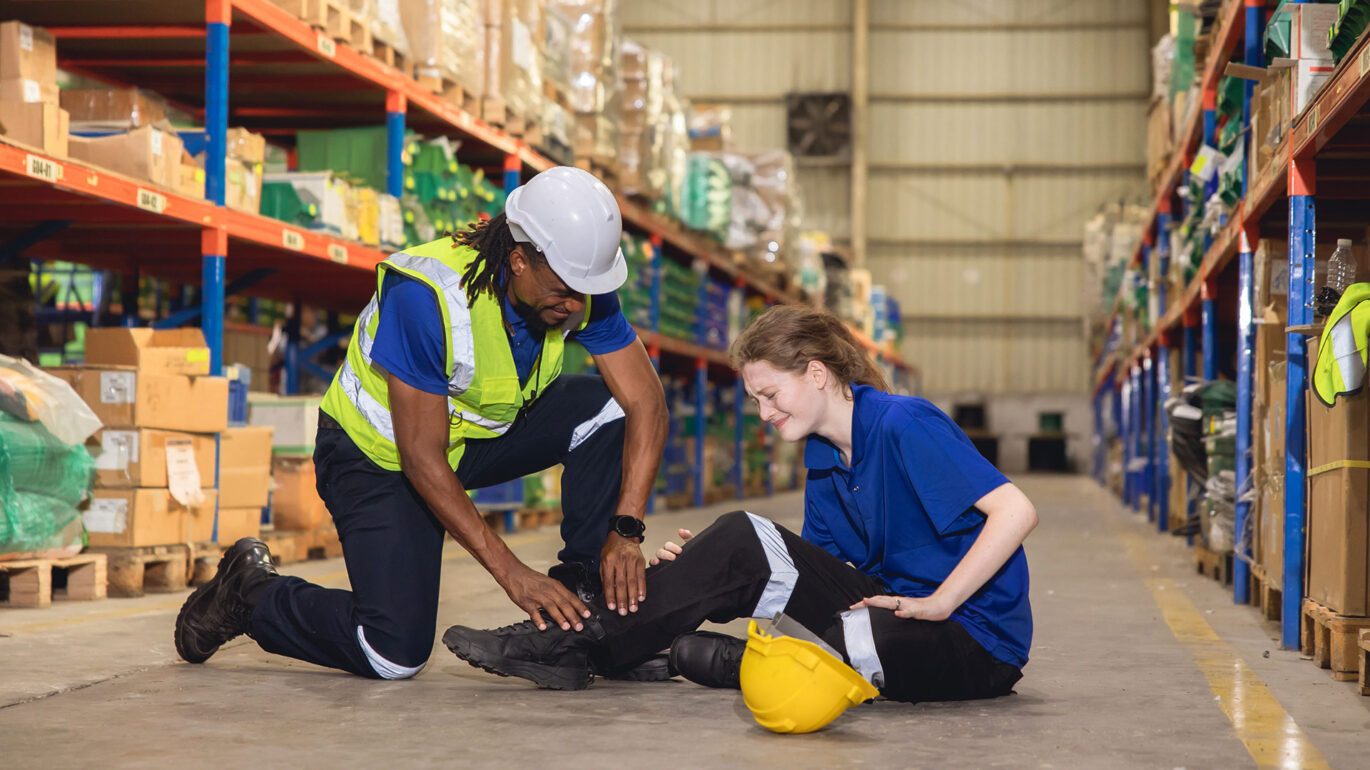Slips, trips and falls are a significant hazard in warehouse and distribution centres which can lead to debilitating injuries for workers, and high costs for employers, says WSPS Specialized Consultant (Warehouse & Distribution) Norm Kramer.
Norm offers two examples:
- A worker rushes outside in snowy, wet weather to start a vehicle to warm it up. He slips, realizes he’s falling, and uses his arm to cushion the impact. He starts to feel nauseous and faint, and is in considerable pain. The worker has suffered a dislocated shoulder and must wear a sling, attend physiotherapy, and miss work for months. For the employer, this may mean higher workers’ compensation and health care costs, as well as costs to hire a replacement worker.
- A worker is offloading a pallet from a truck with a pallet jack, walking backwards, and trips on a pallet that is lying flat on the floor. The worker falls, hitting their head. The worker calls in sick the next day. Two weeks later, the worker passes away as a result of the head injury. The employer is charged under provincial legislation and is fined $60,000.
“Employers in warehouse and distribution centres need to be particularly proactive when it comes to prevention because the potential for slips, trips and falls is everywhere,” notes Norm. They can occur in the yard, on the warehouse floor, the transition areas between the outside and the inside (uneven or slippery floor surfaces), while products are being loaded/unloaded (empty pallets, debris or spills), and while working at heights on ladders, to name a few.
10 tips to prevent slips, trips and falls
Create a safer and healthier environment for your workers by following these tips for reducing slips, trips, and falls in your workplace:
- Implement good housekeeping practices:
- Clean up spills and wet surfaces immediately. “Common areas prone to slips, trips and falls, include high traffic areas and entrances,” says Norm.
- Keep walkways and aisles clear of obstacles and clutter.
- Ensure proper storage and organization of materials.
- Regularly inspect and maintain flooring, including cleaning and repairing cracks or uneven surfaces.
- Ensure adequate and unobscured lighting on walkways, staircases, and high-traffic areas. “Also consider outdoor lighting levels,” suggests Norm. “During low light conditions in the fall and winter, it is more difficult to see obstructions because of poor housekeeping or imperfections on the pavement. During regular inspections, walk through the yard when it is dark outside to identify hazards and determine risks.”
- 4. Use brightly coloured warning signs to alert workers to a slip hazard, such as wet floor signs. When the hazard is gone, remove the sign. “If left in place indefinitely, warning signs will not be taken seriously,” cautions Norm.
- Identify the causes of unsafe behaviours (e.g., rushing, distractions, overreaching, fatigue). Is your company sending the message that productivity is more important than health and safety? Are you communicating your policies and practices effectively? Are supervisors adequately enforcing your practices?
- Don’t forget about seasonal risks. For example, pools of melted snow in transition areas, or icy patches on potholes in the yard. Repair potholes and take the time to clear snow and apply salt and sand as appropriate. Norm suggests stocking up on salt/sand and keeping it readily available close to the hazard or walking path. Remember that not only are your workers at risk, but also contract drivers,” notes Norm.
- 7. Ensure drivers or workers don’t track in rain or snow. “Make sure you have mats in place at each entrance so that those entering the building can dry their feet before walking on your floor.” Replace mats if they become saturated with water. Make sure this is part of your housekeeping protocol with assigned responsibility.
- Pay attention to the loading dock area, especially during inclement weather. “Review your dock seals or shelters to ensure that air entering the dock will not cause condensation or wetness on the steel dock plate, contributing to slip hazards and lift trucks skidding and sliding,” says Norm. “Also, a poor seal may result in snow or rain entering the dock area.” Preventative maintenance includes making sure you have a good seal around trailers that are parked at your loading dock.
- Don’t overlook risks associated with ladders and mobile equipment. Train your workers to:
- always use handrails
- carry objects with one hand (if permitted), leaving one hand available to grip the handrail
- only carry loads that fit within the handrail
- face the ladder when ascending and descending if required by manufacturer
- not overreach a handrail or guardrail
- keep the ladder close to the work and be readily available to achieve 3-point contact (two feet and one hand).
- Encourage workers to report hazards and near misses. Take immediate action to correct the problem.
How WSPS can help
Training
- Preventing Falls from Slips & Trips (eCourse, 1 hour)
Videos
- Workplace slips, trips and falls
- Warehouse Safety Tips – Understand your risks
- Warehouse Safety Tips: Assess Your Warehouse Risks
Resources
- Workplace slips, trips and falls (article)
- Stop slips, trips and falls with these expert tips (article)
- Slips, trips and falls: 6 ways to combat winter hazards (article)
- Traction Always – Slips, Trips and Falls Poster
- 12 ways to engage workers in slip, trip and fall prevention (article)
- Walking and Working Surfaces (guide)
- Preventing Slips, Trips and Falls Guide (article)
The information in this article is accurate as of its publication date.



